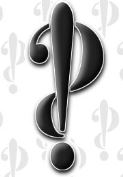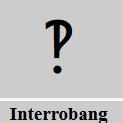Hi Folks,
 When I edit a manuscript, my sole purpose is to make the reading experience seamless for the reader, thereby enhancing the writer’s reputation for excellent writing. When I’m finished there should be no rough edges over which the reader can stumble, no ambiguity or lags in the flow of information that can momentarily confuse the reader, and no punctuation that fails to direct the reading of the work and help convey the mood of the moment.
When I edit a manuscript, my sole purpose is to make the reading experience seamless for the reader, thereby enhancing the writer’s reputation for excellent writing. When I’m finished there should be no rough edges over which the reader can stumble, no ambiguity or lags in the flow of information that can momentarily confuse the reader, and no punctuation that fails to direct the reading of the work and help convey the mood of the moment.
We probably are all aware of the “new” punctuation mark that’s actually been around since 1962, the interrobang. It looks like an exclamation point imbedded in question mark. It’s intended to convey the exclamatory question. I was going to show you one in context, but most fonts don’t include it yet, so I’ve slipped in a couple of photos instead. The one above is a stylized photo from http://interrobang-mks.com/ and the one below is the way the interrobang appears in Microsoft Word’s Wingdings 2 collection. (To find it go to Format, choose Fonts, then Wingdings 2. To find the interrobang, on your keyboard select the ~ or the } or the ^ (the carat above the 6) or the _.)
Note that the interrobang would be used only in dialogue as the narrator never has a reason to display emotion of any kind, even when he’s also a character. As in real life, the narrator and character roles are different even when they’re played by the same person. But back to reality for a moment. To keep the interrobang in the font you’re using through the rest of the manuscript, I advocate using a question mark followed by an exclamation point: “What the hell are you doing?!”
played by the same person. But back to reality for a moment. To keep the interrobang in the font you’re using through the rest of the manuscript, I advocate using a question mark followed by an exclamation point: “What the hell are you doing?!”
The question mark should come first because “What the hell are you doing?” is a question. The exclamation point simply indicates that the question was presented in a stressed voice. (Of course, the way the question is worded indicates a bit of stress even without the exclamation point.) Here’s the question presented differently to indicate increasing levels of stress:
“What the hell are you doing?”
“What the hell are you doing?”
“What the hell are you doing?!”
“What the hell are you doing?!”
And that isn’t all. In my current editing project, I ran across the situation that stirred this blog post in the first place: a terse statement (again, in dialogue) that had been interrupted by the other character. Here’s that snippet of conversation:
“You don’t give a damn about our race, you pompous son of a—!”
“I’ll tell you one thing, William, and listen to me closely.”
Of course, we know to use the em dash to indicate the abruptness of an interruption. To indicate an exclamation that’s been interrupted, as in the excerpt above I advocate using the em dash followed by the exclamation point: “What the—!” or “Oh man! Holy sh—!” or “But Manuel, I love—!” or “¡Pero Maria, te amo—!”
(Now, for those of you who still believe you should use an ellipsis to indicate an interruption, please don’t. Remember that the ellipsis creates a pause of indeterminate length; that is, whether the pause is medium or long or somewhere in between depends on the context. That’s why the ellipsis is appropriate to indicate halting speech or dialogue trailing away at the end of a sentence—there’s nothing abrupt about it—so to juxtapose the ellipsis with an exclamation point simply wouldn’t work. If I may personify the two marks for a moment, the lackadaisical attitude exhibited by the ellipsis would clash with the sense of urgency conveyed by the exclamation point.)
So there y’go. If you’re wondering about any other punctuation marks or if you believe you’ve discovered new, innovative uses for them or for combinations, please add a comment below.
‘Til next time, happy writing!
Harvey

I am really glad for this post! Thank you, Harvey! I honestly thought that I was the only person who used (and quite illegally) the question mark and exclamation mark side by side! I finally talked myself into leaving out the illegal (as far as I knew) exclamation marks, so I don’t even know where I’d look to see if I truly put the question mark first when I did use the two marks together. I think it was first, though, as your reasoning sounds very familiar to me (like I might have had similar reasoning).
This post has helped me appreciate again the wonderful hope that we all must have for our written expression, i.e., that it really conveys the meaning that we intend. Now, please tell me if my favored use of punctuation other than a comma (as seen below), also regretfully abandoned once recently, is also basically acceptable.
Thanks!
Candy
Hi Candy,
If you mean using the exclamation point after Thanks rather than the comma, if that’s how you feel you should certainly use it. In every case, punctuation (like the words whose reading it directs) should be used intentionally and willfully to convey the writer’s meaning.
Thanks!
Harvey 🙂
That’s good to hear, Harvey!
Thanks!
Candy
🙂
Great article! That is the type of information that are supposed to be shared around the web.
Disgrace on Google for no longer positioning this submit upper!
Come on over and consult with my website . Thank you =)
If some one desires expert view about running a blog then i recommend him/her to pay a quick visit
this webpage, Keep up the nice work.